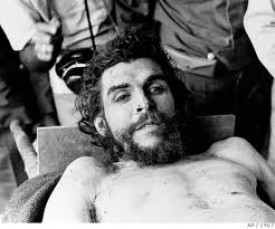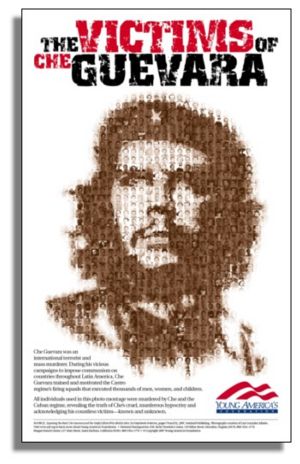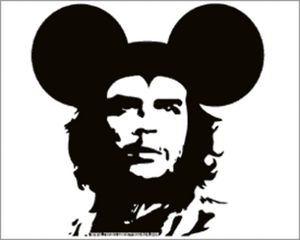Ernesto "Che" Guevara (born June 14, 1928, executed October 9th, 1967) was a Marxist guerrilla leader, with Fidel Castro, during the Cuban Revolution. He has become a cultural icon for liberals, leftists, socialists, communists, illegal aliens,[1] and white "hipsters".[2][3]
As Castro's executioner, he came to be known as "The Butcher of La Cabana," rallying up a massive body count even though he himself was easily cowed by anyone with guns regardless of if he was armed or not.[4][5] Despite being a terrorist, his image is still used as leftist propaganda which adorns millions of T-shirts and dorm room posters. "Ernesto Guevara failed spectacularly at everything he attempted in his life--except at the mass-murder of defenseless men and boys."[6]
- Che wasn’t really a gentle soul and a selfless hero. He was a violent Communist who thought nothing of firing a gun into the stomach of a woman six months pregnant whose only crime was that her family opposed him. And he was a hypocrite who lusted after material luxuries while cultivating his image as a man of the people. (Amazon)
Guevara captured and killed by Bolivian soldiers after his small guerrilla army had entered their country. Guevara begged for mercy that he did not give his victims: "Do not shoot! I am Che Guevara and I am worth more to you alive than dead."[7] The Bolivian President ordered his execution.
Contents
Early life[edit]
Guevara was the eldest of five children born in Rosario, Argentina. His schoolmates nicknamed him "pig" (El Chancho) because he rarely bathed, and smelled bad.[8] He also enjoyed killing dogs.[9]
Cuba Revolution[edit]

In 1955, while living as a hobo, Guevara met Raul and Fidel Castro to plot the overthrow of the US-backed Fulgencio Batista government in Cuba. Their first revolutionary plan was an assault on Cuba from Mexico. During the war, Castro promoted Guevara to commander status, and Guevara won the Battle of Santa Clara. This defeated Batista's forces and allowed the bearded guerrillas to march on towards Havana. A series of promotional news articles in The New York Times written by Herbert Matthews bolstered the popularity of the revolutionaries. On New Year's Eve 1958, Batista's forces were defeated and on New Year's Day, Batista fled to the Dominican Republic. Castro and Guevara became Cuba's new socialist revolutionary leaders. Guevara killed many thousand people, who were "enemies of the revolution". Those "enemies" were Homosexuals, dissidents or AIDS-infected people.[11]
Castro's Cuba[edit]
Guevara was appointed commander of the La Cabaña Fortress prison. He oversaw the trial and execution of many former Batista regime officials. Roberto Martin-Perez was imprisoned for 30 years in Castro's dungeon prison. Roberto says "Castro ordered mass murder ... in order to consolidate his power." Guevara, as Castro's chief executioner, relished the slaughter of defenseless men and boys.[12] Guevara became feared for his brutality and ruthlessness. During the 1961 Bay of Pigs invasion, Castro ordered Guevara to take up a command post in Western Cuba. He never saw any fighting and did not participate in the Cuban victory. However, he dropped his pistol and shot himself in the face. Guevara was the main proponent of missiles in Cuba and urged Khrushchev to nuke the United States.[13]
Despite the overall pro-USSR culture of the Cuban revolution, Che found a certain veneration for Maoist China.[14] He visited China in the mid 1960's and met Mao.
In December 1964, he gave a speech before the U.N. General Assembly mocking the "imperialism" of the USA, and also freely admitting that he killed and will continue to kill "enemies of the revolution."
The number of executions he ordered is unknown, with conservative estimates ranging from 400 to 2,000 over his lifetime. Unfortunately, lack of records mean that the exact number will probably never be known.
| “ | “Hatred as the central element of our struggle! Hatred that is intransigent…hatred so violent that it propels a human being beyond his natural limitations, making him violent and cold- blooded killing machine...We reject any peaceful approach. Violence is inevitable. To establish Socialism rivers of blood must flow! The imperialist enemy must feel like a hunted animal wherever he moves. Thus we’ll destroy him! These hyenas are fit only for extermination. We must keep our hatred alive and fan it to paroxysm! The victory of Socialism is well worth millions of atomic victims!”
-- Ernesto "Che" Guevara speaking about Americans, April 1966 Message to the Tricontinental Conference in Havana, Cuba |
” |
South America[edit]
Guevara authored an insurgent booklet entitled Guerrilla Warfare.[15] He left Cuba to lead a Communist guerrilla movement in South America. Bolivian soldiers, trained, equipped and guided by U.S. Green Beret and CIA operatives such as Felix Rodriguez,[16] hunted him down in the Bolivian jungle where he was captured. He cried out "Do not shoot! I am Che Guevara and worth more to you alive than dead." [17]
However, the U.S. and Bolivia knew better. Due to his violent nature, the Bolivians wanted to decapitate his head as proof that he was finally gone. However, being repulsed at the grotesque nature of this the soldiers who captured Che instead chopped off his hands and put them into a jar of formaldehyde as proof.[18][19] He was executed by Mario Terán 2 days later.
Legacy[edit]
Because of the Soviet's all-time low popularity at the time, and by extension all of Communism, Che was immortalized by Castro by implementing a romantic version of Che as part of a propaganda campaign shortly after Che's death in Bolivia. One of the people instrumental in this campaign was French philosopher Jean-Paul Sartre, who himself was a Communist in bed with the KGB, having referred to Che Guevara as "the most complete human being of our time." Ion Mihai Pacepa had heard of the propaganda campaign back when he was still serving the Romanian communist party.[20] As such, alongside Chinese dictator and mass-murderer Mao Zedong, Che's image has (ironically enough) been used for merchandising.
Quotes[edit]
- "At the risk of seeming ridiculous, let me say that the true revolutionary is guided by a great feeling of love. It is impossible to think of a genuine revolutionary lacking this quality."
- "In capitalist society individuals are controlled by a pitiless law usually beyond their comprehension. The alienated human specimen is tied to society as a whole by an invisible umbilical cord: the law of value. This law acts upon all aspects of one's life, shaping its course and destiny. The difficult thing for someone not living the experience of the revolution to understand is this close dialectical unity between the individual and the mass, in which the mass, as an aggregate of individuals, is interconnected with its leaders."
- "Instead they must dedicate themselves to study, work and military service! Youth should learn to think and act as a mass. It is criminal to think of individuals! Individualism must disappear from Cuba!"[21]
- "The negro is indolent and lazy, and spends his money on frivolities and drink, whereas the European is forward-looking, organized and intelligent.” [22]
Video[edit]
Books[edit]
- Che Guevara and the Useful Idiots Who Idolize Him, Humberto Fontova.
- Exposing the Real Che Guevara: The Liberal Media's Favorite Executioner, Humberto Fontova, Sentinel, April 2007 ISBN 1595230270 [1]
- Che Guevara Planned Attacks Against the U.S. Humberto Fontova, Newsmax.com, November 21, 2007
See also[edit]
References[edit]
- ↑ Illegal Immigrants Rally For Dead Marxist Che Guevara
- ↑ Che-Mart
- ↑ Reiland, Ralph R. (August 12, 2018). Che Guevara: Romanticizing Tyranny. The New American. Retrieved August 12, 2018.
- ↑ Fidel's Executioner, Con't
- ↑ https://freerepublic.com/focus/f-news/1508197/posts
- ↑ Che Guevara: Mass Murderer and Coward
- ↑ https://historicaltruthproject.com/tag/che-guevara-worth-more-to-you-alive-than-dead/
- ↑ Ernesto "Che" Guevara, Forty Years, Still Dead The Jawa Report, October 8, 2007
- ↑ Exposing the Real Che Guevara: and the Useful Idiots who Idolize Him, By Humberto Fontova
- ↑ https://www.ihatethemedia.com/10-che-guevara-quotes-the-left-would-rather-not-talk-about
- ↑ http://www.slate.com/articles/arts/culturebox/2004/09/the_cult_of_che.html
- ↑ Che Guevara: Mass Murderer and Coward Frontpage Magazine, June 13, 2007
- ↑ Hari, Johann Should Che Be an Icon? No
- ↑ MEMORANDUM OF CONVERSATION BETWEEN MAO ZEDONG AND ERNESTO 'CHE' GUEVARA
- ↑ Mugshot of a Murderer Yaf.org
- ↑ The Death of Che Guevara: Declassified The George Washington University
- ↑ The Death of Che Guevara: Declassified The George Washington University
- ↑ On Anniversary of Che Killing, CIA's Felix Rodriguez Remembers
- ↑ The Death of Che Guevara Declassified
- ↑ Who was the Real Che? by Ion Mihai Pacepa on FrontPageMag.com
- ↑ http://frontpagemag.com/2013/humberto-fontova/young-americas-foundation-celebrates-no-more-che-day/
- ↑ http://archive.is/wip/XRT8d
External links[edit]
- Socialist Hero Che Guevara: Racist, Homophobe & Mass Murderer
- Guevara was a notorious homophobe., History Collerction.



